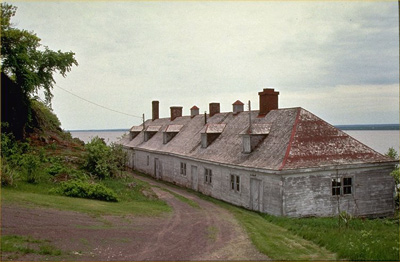Grosse Île and the Irish Memorial National Historic Site of Canada
Grosse-Île, Quebec

General view
© Parks Canada Agency / Agence Parcs Canada
Address :
Grosse-Île, Quebec
Recognition Statute:
Historic Sites and Monuments Act (R.S.C., 1985, c. H-4)
Designation Date:
1974-05-18
Dates:
-
1832 to 1937
(Significant)
-
1832 to 1832
(Significant)
Event, Person, Organization:
-
Irish Potato Famine and typhus epidemic, 1847
(Event)
-
Dr. Frederick Montizambert
(Person)
Other Name(s):
-
Grosse Île and the Irish Memorial
(Designation Name)
-
Grosse Île and Immigration to Canada Grosse Île et l'immigration au Canada
(Plaque name)
Research Report Number:
1983-019, 1984-007, 1992-A08 1992-OB10
DFRP Number:
56522 00
Plaque(s)
Existing plaque: just outside the Parks Canada Boutique Grosse-Île, Quebec
Grosse Île and the Irish Memorial National Historic Site commemorates the significant waves of immigration welcomed to Canada between the opening of the 19th century and the First World War. During this period Québec was Canada's chief port of entry, receiving more than four million immigrants. Deadly infectious diseases and a rudimentary scientific understanding of how they could be controlled required that, between 1832 and 1937, Grosse Île serve the vital function of a quarantine station protecting the public health. Priests, doctors, nurses and other staff often risked their own lives to welcome and care for the new arrivals. Grosse Île also serves as a memorial to the tragic events endured by Irish immigrants here, chiefly during the typhus epidemic of 1847, when nearly 100,000 people, the majority escaping the Great Famine then ravaging Ireland, set sail for Canada. More than five thousand ended their journey buried on this island.
Description of Historic Place
Grosse Île National Historic Site is located on an island of the same name in the St. Lawrence River. It is the site of a 19th and early 20th century quarantine station. Today it contains built, archaeological and cultural landscape resources that survive from this 1832-1937 period of use as well as a Celtic Cross erected in 1909 to commemorate the Irish immigrants who died there.
Heritage Value
Grosse Île and the Irish Memorial National Historic Site commemorates the importance of immigration to Canada, especially immigration through the entry port of Québec, from the early 19th century until World War I; the tragic experiences of Irish immigrants at this site, especially during the 1847 typhus epidemic; and the role played by the island, from 1832-1937, as a quarantine station for the port of Québec, for many years the main point of entry for immigrants to Canada.
The heritage value of the site resides in the cultural landscape and its component parts that illustrate the process of immigration and quarantine of 19th century immigrants to Canada through the port of Quebec, particularly the Irish during the mid-19th century.
Among its residents was Dr. Frederick Montizambert, medical superintendent of the island during the last 30 years of the 19th century. His belief in the new science of preventative medicine (microbiology, epidemiology, disinfection, vaccinations) caused him to develop a new generation of Canadian quarantine stations which protected Canadians from the deadly epidemics that ravaged many parts of the world at the time
Source
HSMBC Minutes, 1974, 1983, 1993, 1998, and the 1996 Ministerial announcement on Commemorative Intent
Character-Defining Elements
Key elements that contribute to the heritage value of this site include : the cultural landscape located on the island's south shore, comprised of three distinct activity sectors the linkage of the sectors by a road, the length of the island the collection of modest, vernacular, wooden buildings and two in brick the memorial sites, including graveyards and the Celtic Cross monument the setting, isolated by the forested, northern portion of the island and by the waters of the St. Lawrence River
Western Sector buildings from the 19th and 20th centuries, including the disinfection building, carpentry and plumbing workshops, hotels, wash house, bakery, kitchen, the electrician's house, the vaccination and medical examination office, the guard house, and assistant physician's house in their found form, massing, materials, and spacial relationships the Irish cemetery with its grassed, unmarked graves and the doctors' monument the Celtic Cross memorial in its form, materials and setting the west wharf with vestiges of the 1846-1847 original and various engineering structures archaeological vestiges
Central sector built node including the sailors' quarters, Anglican and Roman Catholic chapels, Catholic Presbytery, the Marconi station, the house of the Public works official, the doctor's house, the workshop, the school, the nurses' residence, and the Superintendent's Shed in their found form, massing, materials, and spacial relationships the cannon battery cemetery vestiges of the lower wharf and engineering works archaeological remnants.
Eastern sector lazaretto cemetery, sub-divided into Catholic and Protestant sectors 1881 hospital laundry; - infections desease hospital foundations; - numerous archaeological remnants»